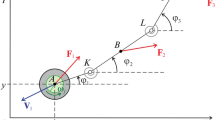Abstract
For the snake-like robot with passive wheels, the side constraint force provides the required thrust which is less than the maximum static friction. Minimizing the side constraint force can reduce possibility of skidding which is important to ensure stable and efficient motion of the robot. In this paper we model the snakelike robot based on the fiber bundle theory. This method can reduce the complexity of the dynamics and derive the exact analytical solution for the side constraint force which is linear to the redundant torque. Using the linear relation, we can derive directly the optimal torque by minimizing the side constraint force. Additionally the nonholonomic constraint can be used for constructing the connection of the fiber bundle. Using the connection, we can select the gait of the snake-like robot. The position and orientation of the head can be described in terms of the special Euclidean group SE(2) which is also the structure group of the fiber bundle. Using the symmetry of the structure group, we can reduce the dynamics equations and derive the analytical solution for the side constraint force. Kinematics and dynamics simulations validate the proposed methods.
Similar content being viewed by others
References
Ma S G. Analysis of creeping locomotion of a snake-like robot. Adv Robot, 2001, 15: 205–224
Saito M, Fukaya M, Iwasaki T. Serpentine locomotion with robotic snakes. IEEE Contr Syst Mag, 2002, 22: 64–81
Ostrowski J, Burdick J. The geometric mechanics of undulatory robotic locomotion. Int J Robot Res, 1998, 17: 683–701
Ostrowski J, Burdick J. Gait kinematics for a serpentine robot. In: Proceedings of IEEE International Conference on Robotics and Automation, Minneapolis, 1996. 1294–1299
Transeth A A, van de Wouw N, Pavlov A, et al. Tracking control for snake robot joints. In: Proceedings of IEEE/RSJ International Conference on Intelligent Robots and Systems, San Diego, 2007. 3539–3546
Pendar H, Vossoughi G, Khoshnood A, et al. Assisted passive snake robots: conception and dynamic modeling using Kane’s method. In: Proceedings of ASME International Mechanical Engineering Congress and Exposition Orlando, Florida, 2005
Vossoughi G, Pendar H, Heidari Z, et al. Assisted passive snake-like robots: conception and dynamic modeling using Gibbs-Appell method. Robotica, 2007, 26: 267–276
Ali S. Newton-Euler Approach for Bio-Robotics Locomotion Dynamics: from Discrete to Continuous Systems. Dissertation for the Doctoral Degree. Nantes: Ecole des Mines de Nantes, 2011
Ostrowski J, Lewis A, Murray R, et al. Nonholonomic mechanics and locomotion: the snakeboard example. In: Proceedings of IEEE International Conference on Robotics and Automation, San Diego, 1994. 2391–2397
Ostrowski J. The Mechanics and Control of Undulatory Robotic Locomotion. Dissertation for Doctoral Degree. Pasadena: California Institute of Technology, 1995
Kelly S D, Murray R M. Geometric phases and robotic locomotion. J Robot Syst, 1995, 12: 417–431
Bullo F, Lewis A D. Kinematic controllability and motion planning for the snakeboard. IEEE Trans Robots Automat, 2003, 19: 494–498
Shammas E, Choset H, Rizzi A A. Natural gait generation techniques for principally kinemtical systems. In: Thrun S, Sukhatme G S, Schaal S, eds. Proceedings of Robotics: Science and Systems. Cambridge: MIT Press, 2005
Shammas E, Choset H, Rizzi A A. Geometric motion planning analysis for two classes of underactuated mechanical systems. Int J Robot Res, 2007, 26: 1043–1072
Ishikawa M. Iterative feedback control of snake-like robot based on principal fiber bundle modeling. Int J Adv Mech, 2009, 1: 175–182
Boyer F, Ali S. Recursive inverse dynamics of mobile multibody systems with joints and wheels. IEEE Trans Robot, 2011, 27: 215–228
Boyer F, Ali S, Porez M. Macrocontinuous dynamics for hyperredundant robots: application to kinematic locomotion bioinspired by elongated body animals. IEEE Trans Robot, 2012, 28: 303–317
Wang Z F, Ma S G, Li B. A unified dynamic model for locomotion and manipulation of a snake-like robot based on differential geometry. Sci China Inf Sci, 2011, 54: 318–333
Hirose S. Biologically Inspired Robots (Snake-Like Locomotor and Manipulator). Oxford: Oxford University Press, 1993. 1–49
Author information
Authors and Affiliations
Corresponding author
Rights and permissions
About this article
Cite this article
Guo, X., Ma, S., Li, B. et al. Modeling and optimal torque control of a snake-like robot based on the fiber bundle theory. Sci. China Inf. Sci. 58, 1–13 (2015). https://doi.org/10.1007/s11432-014-5253-y
Received:
Accepted:
Published:
Issue Date:
DOI: https://doi.org/10.1007/s11432-014-5253-y




